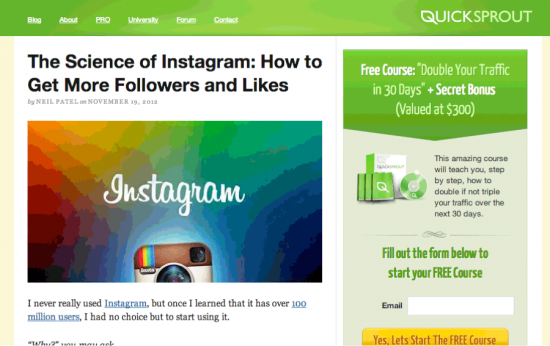
Folks are writing content, sharing it, linking, testing, and measuring it …
But, some of them forget that traditional direct-response copy skills are still working in today’s content boom.
Take for instance, writing conversationally. This popular advice is accepted as one of the best ways to get better conversions.
Unfortunately many boil it down to one line of advice …
“Just write like you talk.”
It’s frustrating because in a way it’s true – yet so many content creators take it out of context …
“Write like you talk” doesn’t mean to literally write the words you say. As Taylor Lindstrom points out:
“If you wrote the way you talked, your writing would be riddled with space-filler words and phrases such as ‘like’ and ‘um’ and ‘you know what I mean?’”
Instead, “write like you talk” means to write conversationally, connect with your reader, appeal to their emotions – basically be human!
Writing Content Like a Human is Effective

“Your prospect won’t read your writing if it’s too hard to read. He has far too much going on to struggle over your words. Your writing must be an open door leading your reader into your ideas,” Will Newman, Freelance Copywriter, said.
Newman went on to point out that writing conversationally doesn’t mean that you “dumb down” your content.
Instead, you need to master what Newman calls, “simplicity of diction” …
“Simplicity of diction” communicates without trying to impress. It sounds simple … but does not simplify ideas. It sounds natural and conversational. It’s how you must write to be a successful copywriter.
So, how can you learn to write conversationally?
Here are 7 tips:
1. Know your audience.
The more you know about your audience, the better your conversation (i.e. writing) will go. Know what words your readers use, listen to them talk to their friends (forums are great places for this), and really get to know them. Then, when you’re writing content, imagine that you’re talking directly to ONE of your readers.
2. Make goals for your content.
Depending on your content strategy, your goals might be to get someone to click a link, comment, buy something, or trade their name and email for a free report. No matter what your goal is, know it before you start writing content. (This way you won’t “hem and haw” through your lead.)
3. Avoid being clever.
Unfortunately sometimes clever doesn’t come across in our writing. Maybe the reader didn’t understand the joke or stopped reading before they got to the punch line. Either way, the copy didn’t work. Instead, be straightforward.
4. Be friendly.
Your writing should be like a letter to a friend, not a textbook or legal document. Feel free to use slang (as long as your reader will understand it). Use contractions like you’re and you’ll. Occasionally start a sentence with the word “and.” All of this will make your copy conversational and engage your reader.
5. Read it out loud.
When you’re finished writing content, be sure to read it out loud. If anything sounds awkward, reword it. Also, if a sentence takes more than one breath to read it out loud, it’s too long. Try chopping it into two or more sentences.
6. Use simple words.
For instance, “get” is simpler than “acquire.”
7. Practice.
Writing conversationally doesn’t come easy. Which is funny to say considering that humans average 16,000 words in a day.
To see if you’re making progress from your practice, let’s talk about readability scores …
Do you sound human?
“Readability” is basically the measure of whether or not your writing sounds natural and conversational. Luckily a tool called, “The Flesch-Kincaid (FK) scale” makes it easy to gauge your readability.
While the FK tool gives us several scores, we’re going to use the easiest to understand: the FK Grade Level.
Aim to write content that is between 5th and 8th grade levels. Remember the goal is not to dumb down your content. Instead, we want you content to be easy and natural to read.
Let’s look at an example:
At Readability-Score.com you can paste your content to get the FK grade score. Below is a screenshot of Readability-Score.com scoring a paragraph of text:
In the bottom right corner you can see the FK Grade Level score. It’s 11.1 and too high for optimal readability.
Let’s rewrite it – using the 7 tips above – and see what results we get:
Just by replacing a few complex words and shortening a couple sentences, we were able to reduce the FK Grade Level to 7.6!
Does your favorite blogger write like an 8th grader?
When you hear, “write on an 8th grade level,” it’s not because readers are dumb. (Remember, it’s about simplicity of diction.)
As it turns out, some of the most popular and most shared content is below an 8th grade level …
For instance, this popular post from QuickSprout, “The Science of Instagram: How to Get More Followers and Likes” got a 7.3 on the FK scale:
Here’s an example from Copyblogger:
The above article, “How to Decide Which Content to Sell and What to Give Away for Free,” got a 7.1 on the FK scale.
The lead was just 6.6:
Finally, the most popular post here at Bidsketch, “How to Write a Web Design Proposal,” got a 7.5 on the FK scale:
Action Step
Why not perform a readability test on your most popular blog post? Just go to Readability-Score.com.
If your find out that the article’s FK Grade Level is too high, use the tips above to reduce it. You could also republish it to measure it’s effectiveness. Let us know how it goes in the comments below.
Don’t forget …
Writing conversationally is just one piece of the content puzzle. Depending on your content goals you must also learn about things like persuasive writing and sales copy.
What do you think?







